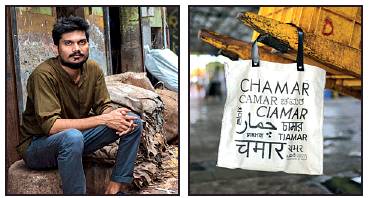Scheduled castes and the fashion industry
This is a collection of articles archived for the excellence of their content. |
2018: When ‘Dalit’ is a brand, ‘Chamar’ a fashion label

From: Yudhajitshankar Das, When ‘Dalit’ is a brand, ‘Chamar’ a fashion label, September 13, 2018: The Times of India
DALIT PRIDE IS SHOWING ON THE STREETS OF INDIA
A debate might be raging on the use of the word itself, but an entire ecosystem is slowly being built around ‘Dalit’ and even ‘Chamar’, with T-shirts that say ‘Kiss me. I’m Dalit’, or ‘It’s a Dalit thing, you wouldn’t understand’. From unpolished grains via Dalit Foods to an aesthetically-crafted handbag from Chamar Studio, from tea mugs with ‘Valmiki’ emblazoned on them to stickers of Ambedkar on bikes, Dalit pride is showing on the streets of India.
A simple Google search for Dalit T-shirt throws up results with bold slogans like ‘Dalit Blood Runs Through My Veins’, ‘Untouchable-Property of Dalit’, or ‘Keep Calm And Say Jai Bhim’. On the metamorphosis — a community that hid its identity was suddenly showing it off — Dalit ideologue Chandra Bhan Prasad said, “With deepening of constitutionalism and advent of capitalism, caste is losing its grip over Dalits. This sense of freedom is making them celebrate who they are.”
Especially in the “castefree zones” of metros — in relative terms, of course — young Dalits say they find it empowering to flaunt their identity. Remember the cars on Delhi roads with ‘Jat’, ‘Gujjar Boy’ or ‘Rajput Inside’ written on them? These days, one can occasionally spot a car with ‘Valmiki Boy’ whizzing past. Not that such assertions go unchallenged. An 18-year-old from Vadodara was thrashed by Darbar community members in August this year for pasting moustache stickers, which is assumed to be a symbol of upper-caste pride, on his bike. In March, a Dalit youth was killed in Gujarat’s Bhavnagar district for owning and riding a horse.
In Mumbai, artist Sudheer Rajbhar has built Chamar Studio, fashioning handbags and tote bags that scream out the label. Rajbhar, who commercially launched Chamar Studio six months ago, added, “I started off with cobblers in Mumbai, mostly Dalits, who run pavement stalls. When the brand expanded, I met a few leather craftsmen from tanneries in Dharavi and associated them with the brand.” Price of the designer products ranges from Rs 1,500 to Rs 6,000 and is disclosed on request.
D Shyam Babu, senior fellow with Centre for Policy Research, said it was a “movement of identity expression”. He added: “It started about 15-20 years back in Tamil Nadu, where members of the Pariah community asserted themselves suffixing Pariah to their names.” Etymologically, that’s where the English word, which means outcast, originates. “With some articulate individuals in the lead, assertion of Dalit identity is happening widely now. It’s a way of turning the tables and declaring I am not inferior.”
Brand Dalit isn’t limited to India. UK-based charity Life Association uses Dalit Goods Co as its trading arm to sell candles, which it says are made in Mumbai, with sale proceeds going to a children’s home in Andhra Pradesh.